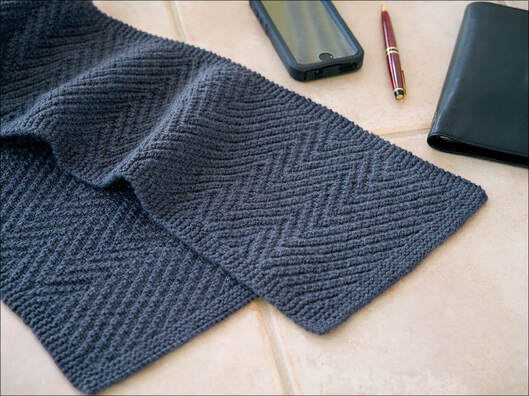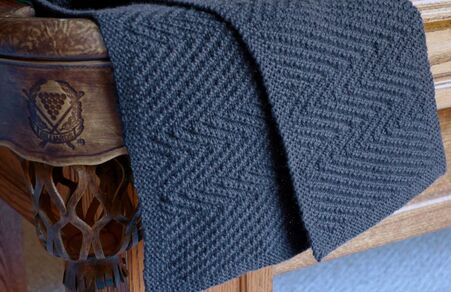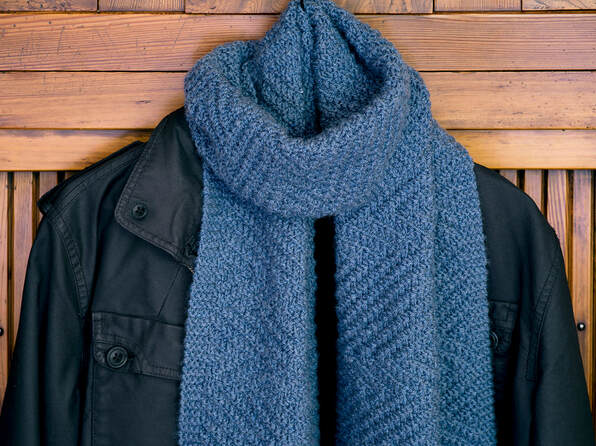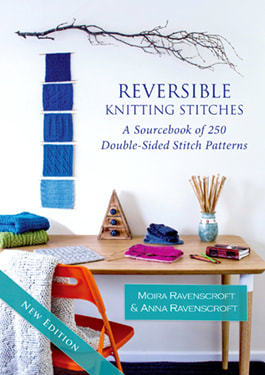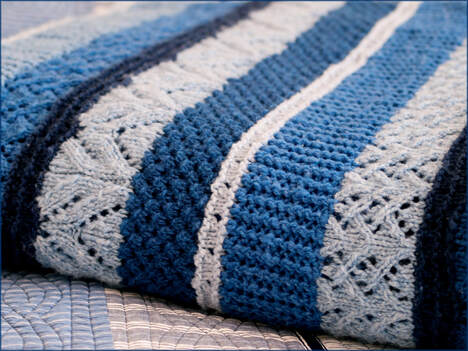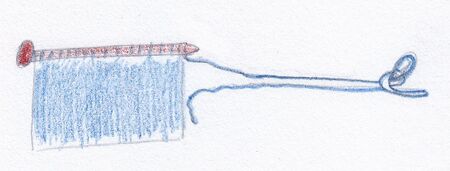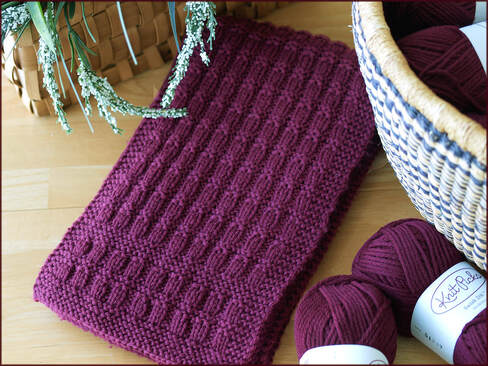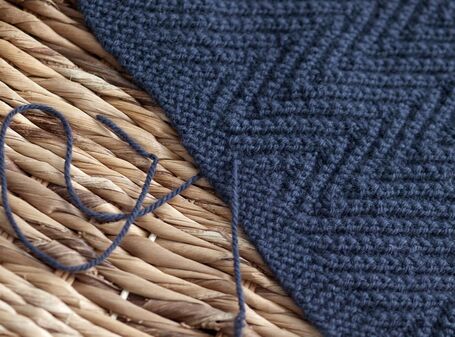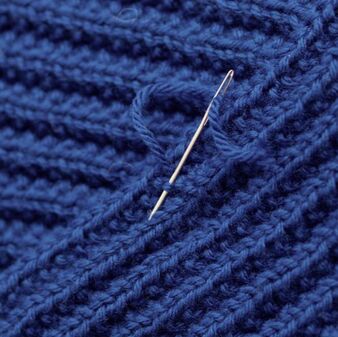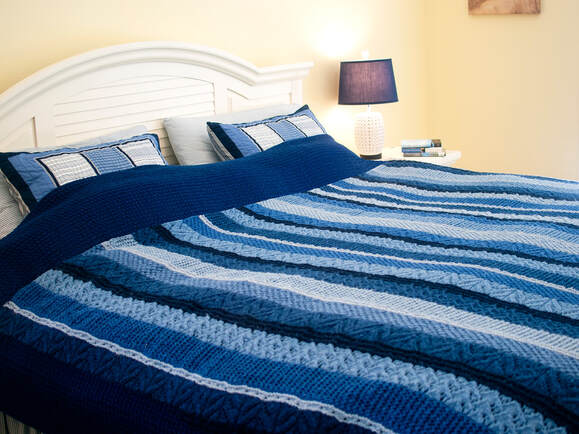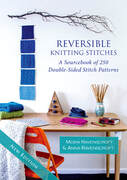I love this time of year. The almost-chaotic build up to the holiday season has passed and a quiet contentment has set in. Good food, good company and lots of plans for the year ahead.
Many people feel a bit gloomy at the thought of the long, dark winter evenings ahead, but for us knitters this is not an issue. If it's cold outside, you can curl up in front of a warming fire and either start working on an item that have been languishing for a while in the "To Do" basket or start a brand new project.
Well, here's a new scarf pattern that might be a good choice for that fire-side knitting session — the Lamberhurst Scarf. I designed this as a man's scarf, but with a different choice of yarn or colour it could just as easily work for ladies too.
Many people feel a bit gloomy at the thought of the long, dark winter evenings ahead, but for us knitters this is not an issue. If it's cold outside, you can curl up in front of a warming fire and either start working on an item that have been languishing for a while in the "To Do" basket or start a brand new project.
Well, here's a new scarf pattern that might be a good choice for that fire-side knitting session — the Lamberhurst Scarf. I designed this as a man's scarf, but with a different choice of yarn or colour it could just as easily work for ladies too.
I started knitting this on my birthday earlier this month. It wasn't one of those "special" birthdays, nothing with a '0' or a '5' at the end, but each one counts doesn't it?
However, I got to musing on previous birthdays and I recall one unusually warm December day walking in Lamberhurst in Kent. We had togged ourselves up with mittens and scarves, but on that day they weren't needed. So we carried them in our hands as we walked along and enjoyed the winter sunshine slanting through the trees.
I expect had we been walking there today it might have been a different story, as it's very chilly right now!
However, I got to musing on previous birthdays and I recall one unusually warm December day walking in Lamberhurst in Kent. We had togged ourselves up with mittens and scarves, but on that day they weren't needed. So we carried them in our hands as we walked along and enjoyed the winter sunshine slanting through the trees.
I expect had we been walking there today it might have been a different story, as it's very chilly right now!
The scarf worked up quickly as the pattern is easily memorised. This was for a draped scarf which falls to about jacket length. I like this length of scarf because it has enough width to cross over at the chest for extra warmth when required but is also very easy to tuck it into the opening of a jacket.
Then when that one was done, I found I still had a lot of yarn left over so I made a second version! My brother was dropping a lot of hints that he would like a new scarf for the winter, so I worked this second one for him. This one was a little slimmer and longer as he likes scarves which can be wrapped and folded multiple times around the neck. Longer scarf lengths are so good for artistic wrapping and folding too. Have a look at this earlier blogpost for some more ideas on that.
Then later I went on to make a chunky winter version too and have included instructions for all three scarves in the pattern.
Then when that one was done, I found I still had a lot of yarn left over so I made a second version! My brother was dropping a lot of hints that he would like a new scarf for the winter, so I worked this second one for him. This one was a little slimmer and longer as he likes scarves which can be wrapped and folded multiple times around the neck. Longer scarf lengths are so good for artistic wrapping and folding too. Have a look at this earlier blogpost for some more ideas on that.
Then later I went on to make a chunky winter version too and have included instructions for all three scarves in the pattern.
The stitch pattern was taken from our new book, Reversible Knitting Stitches and is one of those rare examples when an easy stitch looks complicated. Isn't is great when it works that way around!
I love the texture of this stitch. It catches the light in such an interesting way and gives a wonderful graphic feel. However, as I worked I found that it also reminded me of some wonderful rock formations we had seen a while back where layers of rock had been squeezed and tilted into fan-like shapes.
I love examples like this, of a design which feels so dynamic and modern yet which has echoes of something timeless.
For more details about the Lamberhurst Scarf knitting pattern, please click here. The pattern is available for instant download from the site so you can kick-back and start your fireside knitting tonight.
Happy Knitting!
Moira
I love the texture of this stitch. It catches the light in such an interesting way and gives a wonderful graphic feel. However, as I worked I found that it also reminded me of some wonderful rock formations we had seen a while back where layers of rock had been squeezed and tilted into fan-like shapes.
I love examples like this, of a design which feels so dynamic and modern yet which has echoes of something timeless.
For more details about the Lamberhurst Scarf knitting pattern, please click here. The pattern is available for instant download from the site so you can kick-back and start your fireside knitting tonight.
Happy Knitting!
Moira
Last blogpost: At the end of a row . . . Next Up: The Four-Way Wrap Our book: Reversible Knitting Stitches My Website: www.wyndlestrawdesigns.com |
Keywords: Patterns/Mens Scarves,
scarf, scarves, reversible scarf, reversible pattern, reversible stitch, knitting stitch, zig-zg pattern, chevron pattern,
scarf, scarves, reversible scarf, reversible pattern, reversible stitch, knitting stitch, zig-zg pattern, chevron pattern,
